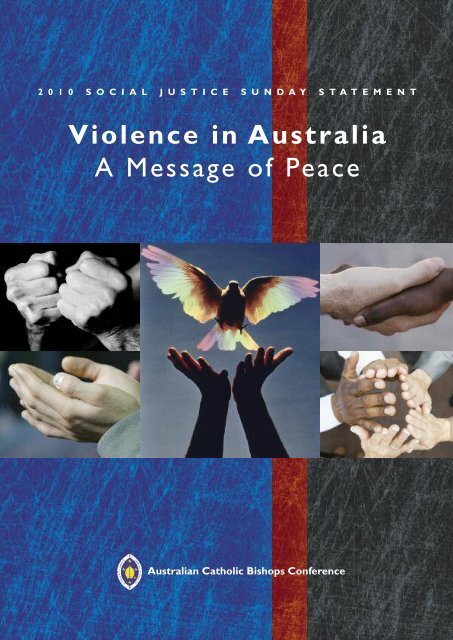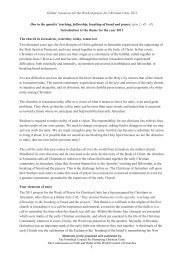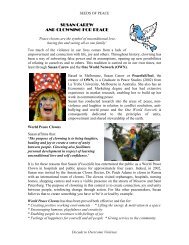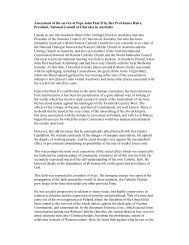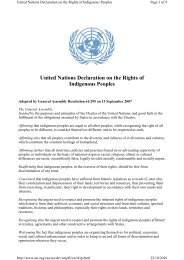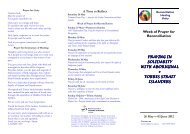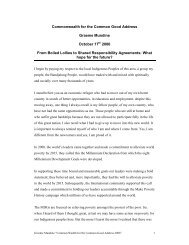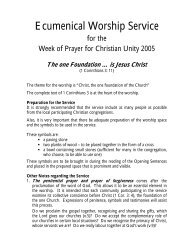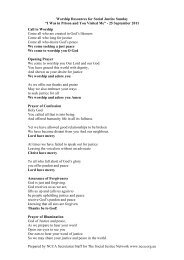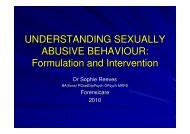Violence in Australia A Message of Peace - Australian Catholic ...
Violence in Australia A Message of Peace - Australian Catholic ...
Violence in Australia A Message of Peace - Australian Catholic ...
You also want an ePaper? Increase the reach of your titles
YUMPU automatically turns print PDFs into web optimized ePapers that Google loves.
2 0 1 0 S O C I A L J U S T I C E S U N D A Y S T A T E M E N T<strong>Violence</strong> <strong>in</strong> <strong>Australia</strong>A <strong>Message</strong> <strong>of</strong> <strong>Peace</strong><strong>Australia</strong>n <strong>Catholic</strong> Bishops Conference
Chairman’s messageOn behalf <strong>of</strong> the <strong>Australia</strong>n <strong>Catholic</strong> Bishops Conference Ipresent the 2010 Social Justice Sunday Statement,<strong>Violence</strong> <strong>in</strong> <strong>Australia</strong>:A message <strong>of</strong> peace.Every day, it seems, we hear news <strong>of</strong> some act <strong>of</strong> gratuitousviolence: someone bashed <strong>in</strong> the street or some violentconfrontation on the roads. Indeed, this Statement beg<strong>in</strong>s with aconsideration <strong>of</strong> just such a confrontation.This is not the only k<strong>in</strong>d <strong>of</strong> violence that should concern us. Manypeople are affected by violence <strong>in</strong> their own homes, and theirlives can be damaged for decades.Young people’s lives can beru<strong>in</strong>ed by campaigns <strong>of</strong> bully<strong>in</strong>g and humiliation by their peers.And we see the culture <strong>of</strong> abuse that at times <strong>in</strong>fects our politicsand our media.For Christians, Jesus Christ is the strongest example and source <strong>of</strong>strength <strong>in</strong> our long journey towards the peace <strong>of</strong> God. He wasthe victim <strong>of</strong> the worst that humanity could do. His response toviolence was not more violence but an act <strong>of</strong> transcendence thatset humanity on a new path forever.The mission and resurrection<strong>of</strong> Jesus are both a message <strong>of</strong> hope to humanity and a call toconversion: to renounce the sources <strong>of</strong> violence and to look fornew and constructive ways <strong>of</strong> address<strong>in</strong>g the pa<strong>in</strong> and anger wesee <strong>in</strong> our world.This Statement is issued at the conclusion <strong>of</strong> the United Nations’International Decade for a Culture <strong>of</strong> <strong>Peace</strong> and Non-<strong>Violence</strong> for theChildren <strong>of</strong> the World and the World Council <strong>of</strong> Churches’ Decadeto Overcome <strong>Violence</strong>. Key goals have been the promotion <strong>of</strong>fundamental human rights, address<strong>in</strong>g wide varieties <strong>of</strong> violence –direct and structural – <strong>in</strong> homes, communities and <strong>in</strong> the<strong>in</strong>ternational arenas, and learn<strong>in</strong>g from local and regional ways <strong>of</strong>overcom<strong>in</strong>g violence.In the Statement examples are given <strong>of</strong> men and women who aremak<strong>in</strong>g their contribution to peace as <strong>in</strong>dividuals, <strong>in</strong> theircommunities, and <strong>in</strong> response to issues <strong>of</strong> national and globalimportance.There are countless others who work tirelessly, and<strong>of</strong>ten without recognition, to br<strong>in</strong>g peace where discord orviolence would otherwise prevail. As we celebrate Social JusticeSunday, let us remember that every effort we take to overcomeviolence is a response to Christ’s call to go <strong>in</strong>to the world andbr<strong>in</strong>g a peace that the world alone cannot give.With every bless<strong>in</strong>g,Christopher A Saunders DDBishop <strong>of</strong> BroomeChairman, <strong>Australia</strong>n <strong>Catholic</strong> SocialJustice CouncilThe <strong>Australia</strong>n <strong>Catholic</strong> Bishops Conference thanks those <strong>in</strong>volved <strong>in</strong> the draft<strong>in</strong>g <strong>of</strong> the 2010 Social Justice Sunday Statement, <strong>in</strong>clud<strong>in</strong>g AndrewHamilton SJ, members <strong>of</strong> the <strong>Australia</strong>n <strong>Catholic</strong> Social Justice Council and its Secretariat. Additional assistance gratefully received from Diane Craig,Phil Glendenn<strong>in</strong>g, Anne Lanyon and Sharron Matayalo.Editors: David Brennan and John FergusonTypesett<strong>in</strong>g and page make-up: project x graphics. Pr<strong>in</strong>t<strong>in</strong>g: L<strong>in</strong>dwall and Ward© <strong>Australia</strong>n <strong>Catholic</strong> Bishops Conference 2010. ISBN: 9781864203523 (Pr<strong>in</strong>t) / 9781864203530 (Onl<strong>in</strong>e).Cover images: Photolibrary.com. Additional photo credits: Fairfax Photos, Getty Images, AAP Images, <strong>Catholic</strong>Care NT,Columban Mission Institute Centre for <strong>Peace</strong>, Ecology & Justice.An electronic version <strong>of</strong> the Statement is available on the <strong>Australia</strong>n <strong>Catholic</strong> Bishops Conference website at www.catholic.org.auand the ACSJC website at www.socialjustice.catholic.org.au<strong>Australia</strong>n <strong>Catholic</strong> Bishops ConferenceThe <strong>Australia</strong>n <strong>Catholic</strong> Bishops Conference is the permanent assembly <strong>of</strong> thebishops <strong>of</strong> our nation and the body through which they act together <strong>in</strong>carry<strong>in</strong>g out the Church’s mission at a national level.The ACBC website atwww.catholic.org.au gives a full list <strong>of</strong> Bishops Conference commissions as wellas statements and other items <strong>of</strong> news and <strong>in</strong>terest.2 s o c i a l j u s t i c e s u n d ay s t a t e m e n t 2 0 1 0
<strong>Violence</strong> <strong>in</strong> <strong>Australia</strong>A <strong>Message</strong> <strong>of</strong> <strong>Peace</strong>You have heard that it was said,‘An eye for an eye and a tooth for a tooth.’…You have heard that it was said,‘You shall love your neighbour and hate your enemy.’But I say to you, love your enemies and pray for those who persecute you …(Matt 5:38, 43–44)On 25th October 2009 Gearoid Walsh, a youngIrish tourist visit<strong>in</strong>g Sydney, became <strong>in</strong>volved <strong>in</strong>an argument at a takeaway shop. He waspunched and fell, hitt<strong>in</strong>g his head on the ground. A weeklater he was dead.Gearoid’s story is tragic and, sadly, an <strong>in</strong>creas<strong>in</strong>gly commonexample <strong>of</strong> anger and frustration explod<strong>in</strong>g <strong>in</strong>to violence.We see how the community’s outrage at such events,<strong>of</strong>ten fanned by media reports, can give rise to calls forretribution and revenge.But the way <strong>in</strong> which his mother, Mrs Treasa Walsh,responded to the death <strong>of</strong> her son made this a remarkablestory. She felt for the man who struck Gearoid:‘I amheartbroken for him because we don’t blame him, wedon’t want him to serve time <strong>in</strong> prison.’ 1The story <strong>of</strong> Gearoid Walsh’s death affects us because itrem<strong>in</strong>ds us pa<strong>in</strong>fully <strong>of</strong> a destructive strand <strong>of</strong> violence <strong>in</strong><strong>Australia</strong>n life. At the same time, the response <strong>of</strong> his familyto his death shows us that peacemak<strong>in</strong>g is more powerfulthan violence.Mrs Walsh’s response rem<strong>in</strong>ds us how radical and centralare Jesus’ teach<strong>in</strong>gs about peacemak<strong>in</strong>g <strong>in</strong> the Gospel. Herconcern for the man whose violent action led to her son’sdeath rem<strong>in</strong>ds us <strong>of</strong> Jesus’ radical <strong>in</strong>vitation to love ourenemies, to do good to those who harm us, to turn theother cheek when we are struck (Matt 5:38–48).There isnoth<strong>in</strong>g weak or cowardly <strong>in</strong> act<strong>in</strong>g <strong>in</strong> this way. It showstrue strength.AJ Photo/photolibrary.comOur Christian faith compels us to be peacemakers <strong>in</strong> theface <strong>of</strong> violence.We all respond to anger and violence atdifferent levels: at the personal level, <strong>in</strong> the family andcommunity, and <strong>in</strong> the wider society.The call to bepeacemakers can be challeng<strong>in</strong>g when other aspects <strong>of</strong> ourpopular culture encourage aggressive attitudes or thedesire to ‘get even’. However, there are <strong>of</strong>ten many simpleways <strong>in</strong> which we can manage anger, prevent violence andbuild peace at all levels <strong>of</strong> society.Discipleship <strong>of</strong> Jesus leads naturally to a desire to makepeace; and his power work<strong>in</strong>g <strong>in</strong> us makes that desire areality. Christians welcome aspects <strong>of</strong> our culture thatdiscourage violence.They treasure peace and are called tobe strong <strong>in</strong> their commitment not only to live peacefullybut to be creative makers <strong>of</strong> peace.<strong>Peace</strong> and peace-build<strong>in</strong>g go beyond simply the absence <strong>of</strong>conflict.They are positive, constructive ways <strong>of</strong> liv<strong>in</strong>g thatrequire constant nurtur<strong>in</strong>g, and that reflect the sacrednessthat is <strong>in</strong> the deepest part <strong>of</strong> our be<strong>in</strong>g – the sacrednessthat is the presence <strong>of</strong> the God <strong>of</strong> peace <strong>in</strong> our world.s o c i a l j u s t i c e s u n d ay s t a t e m e n t 2 0 1 03
v i o l e n c e i n a u s t r a l i a1. <strong>Violence</strong> and peacemak<strong>in</strong>g <strong>in</strong> <strong>Australia</strong>The personal roots <strong>of</strong> violenceWhen we th<strong>in</strong>k <strong>of</strong> violence we <strong>of</strong>ten th<strong>in</strong>k <strong>of</strong> street fights, <strong>of</strong> waror <strong>of</strong> oppression. But the path to violence – and the steeperpath to peacemak<strong>in</strong>g – beg<strong>in</strong>s <strong>in</strong> the <strong>in</strong>dividual human heart.Anger is a normal emotional response to loss, frustration orthe experience <strong>of</strong> <strong>in</strong>justice – either towards oneself or others.It is an emotion that needs to be managed and controlled. Atits worst, it becomes an <strong>in</strong>tense, disproportionate rage.<strong>Violence</strong> can be considered an attempt to control someoneelse by physical and/or psychological force.If we are fortunate <strong>in</strong> our childhood, we learn from ourparents, family and schools how to act peacefully.Theyencourage us to have big desires for th<strong>in</strong>gs beyond ourimmediate needs – desire for friendship, for a closerelationship with God, or to live <strong>in</strong> a more just world.Even if we have good role models <strong>in</strong> life, controll<strong>in</strong>g our angerand be<strong>in</strong>g peacemakers will be a lifetime’s work. It is naturalto feel angry if our desires are frustrated, if we see othersbe<strong>in</strong>g treated unjustly or if our trust is betrayed.The key toact<strong>in</strong>g <strong>in</strong> a peaceful way lies <strong>in</strong> shap<strong>in</strong>g our desires andhandl<strong>in</strong>g our anger creatively. In some circumstances, forexample, the expression <strong>of</strong> a righteous anger can be entirelyappropriate. Anger is a good servant, but not a good master.When people are raised <strong>in</strong> an environment where violence isa common experience, there can be difficulty <strong>in</strong> hold<strong>in</strong>g backfrom act<strong>in</strong>g violently.This response can rise from a well <strong>of</strong> ragethat is fed by the violence they suffered themselves as children.But for all people there can be times when the response tocircumstances that cause anger is out <strong>of</strong> all proportion to theevents that trigger it. In day-to-day life <strong>in</strong> <strong>Australia</strong> we can allspeak <strong>of</strong> examples <strong>of</strong> impatience or anger that result <strong>in</strong> verbalabuse, arguments and fights.This is just one <strong>of</strong> the ways <strong>in</strong>which the personal cycle <strong>of</strong> violence f<strong>in</strong>ds expression.Another comes with the greed that is fed by consumeristculture. In <strong>Australia</strong>, we are <strong>of</strong>ten encouraged to believe thatmaterial th<strong>in</strong>gs are what matter and what we should desire.We are told that we shall be happy if we have the latestclothes, the best cars and the newest gadgets. Our economy isbuilt on consumption.When wealth and possessions are madethe measure <strong>of</strong> happ<strong>in</strong>ess and success, people who are alreadydisadvantaged can easily feel further excluded. Even thosewho are well-<strong>of</strong>f can feel that they are deprived <strong>of</strong> whatsociety says is their entitlement. Exclusion leads to frustration,and frustration can lead to rage and even violence.A preoccupation with material acquisition that stunts humanrelationships has a similarly detrimental impact on how werelate to creation, seen <strong>in</strong> the degradation <strong>of</strong> theenvironment and the waste <strong>of</strong> resources God <strong>in</strong>tended forthe use <strong>of</strong> all. 2We are also told that we should strive to be strong,<strong>in</strong>dividualistic and competitive. People are divided <strong>in</strong>tow<strong>in</strong>ners and losers.We are pushed to make choices and toperform outstand<strong>in</strong>gly. Even at junior levels, sport can focuson w<strong>in</strong>n<strong>in</strong>g and not enjoyment. School is <strong>of</strong>ten aboutachiev<strong>in</strong>g, gett<strong>in</strong>g the highest score, gett<strong>in</strong>g <strong>in</strong>to the mostprestigious faculties.Competition <strong>in</strong> itself is not a bad th<strong>in</strong>g: it can bolster thecommon good when it is based on fair play, shared effort anda concern for those who are vulnerable. A competitivenesswith no rules and a concern to ‘w<strong>in</strong> at all costs’, however,underm<strong>in</strong>es the dignity <strong>of</strong> <strong>in</strong>dividuals and the bonds <strong>of</strong> ourcommon humanity. An overly competitive culture based onselfish <strong>in</strong>dividualism is <strong>in</strong>evitably an angry culture, because forevery w<strong>in</strong>ner there will be a loser whose desires and selfrespectare frustrated.Yet aga<strong>in</strong>, anger can lead to violence.Susanne Borges/AB/photolibrary.com4 s o c i a l j u s t i c e s u n d ay s t a t e m e n t 2 0 1 0
a m e s s a g e o f p e a c eAndrew Meares/Fairfaxphotos<strong>Violence</strong> <strong>in</strong> the family and communityAlthough both violence and peacemak<strong>in</strong>g are ultimatelymatters <strong>of</strong> the human heart, they are played out wherehuman be<strong>in</strong>gs meet. In particular, the home is the place wherewe see the most strik<strong>in</strong>g and generous ways <strong>of</strong> peacemak<strong>in</strong>g.Yet that is also the place where violence <strong>of</strong>ten takes place.We read reports <strong>of</strong> terrible <strong>in</strong>cidents <strong>of</strong> family violence; thosewho work extensively with families know that much moreviolence and abuse goes unreported. Domestic violence is aslikely to be found <strong>in</strong> rich as <strong>in</strong> poor families; those who sufferit are more likely to be women and children. Many <strong>of</strong> thosewho act violently suffered abuse <strong>in</strong> their own childhood.Children <strong>in</strong> these situations, ashamed not to be able toprotect themselves or those they love, can come to associatepeacemak<strong>in</strong>g with appeasement and cowardice. 3If the home is a place <strong>of</strong> hidden violence, it is also the place<strong>of</strong> hidden heroism. People struggle bravely with their anger,forgive one another for their behaviour and make peace <strong>in</strong>difficult situations.We are aware <strong>of</strong> the angers that overflow<strong>in</strong>to violence.We are less aware <strong>of</strong> the courage <strong>of</strong> those whocontrol their feel<strong>in</strong>gs, soothe the angry and try to f<strong>in</strong>d abetter way to resolve conflict. Patience and strength isapparent <strong>in</strong> family members who struggle with normalfeel<strong>in</strong>gs <strong>of</strong> frustration and anger.That does not mean that violence should be enduredpassively.There can be situations where feel<strong>in</strong>gs are not dealtwith adequately and violence can ensue.We recognise thegreat strength displayed by those who seek pr<strong>of</strong>essionalsupport when violence threatens the wellbe<strong>in</strong>g <strong>of</strong> their family.The most publicised <strong>in</strong>cidents <strong>of</strong> violence occur <strong>in</strong> publicplaces where we meet as strangers.We hear <strong>in</strong>creas<strong>in</strong>gRiot at Cronulla, 2005reports <strong>of</strong> road rage; <strong>of</strong> bash<strong>in</strong>gs fuelled by drugs and alcohol;<strong>of</strong> armed robberies on tra<strong>in</strong>s or <strong>in</strong> shops; <strong>of</strong> pr<strong>of</strong>essionalsportsmen <strong>in</strong>volved <strong>in</strong> violence <strong>in</strong> pubs and clubs; <strong>of</strong> playersand umpires be<strong>in</strong>g assaulted even at junior sport<strong>in</strong>g events.Assault, which constitutes the bulk <strong>of</strong> violent crime, has<strong>in</strong>creased by over 50 per cent <strong>in</strong> the decade to 2007. 4While violence can be manifested at all levels <strong>of</strong> society, it isfrequently experienced by those who are powerless,excluded and marg<strong>in</strong>alised. Research shows that homelesspeople are particularly exposed to violence. 5 We know thatIndigenous <strong>Australia</strong>ns are the victims <strong>of</strong> physical orthreatened violence at much higher levels than their non-Indigenous counterparts. 6 Recent <strong>in</strong>cidents where Indianstudents and Sudanese migrants have been attacked rem<strong>in</strong>dus that cultural m<strong>in</strong>orities can be vulnerable.And what <strong>of</strong> the psychological bombardment <strong>of</strong> violencethrough television, the movies, network<strong>in</strong>g sites and violentcomputer games? We are concerned at how children, even atan early age, are now be<strong>in</strong>g encouraged through these mediato th<strong>in</strong>k and act aggressively. Many young people too aresubjected to verbal aggression or <strong>in</strong>ternet bully<strong>in</strong>g.They arebelittled, have derogatory remarks posted and false storiestold about them.This can extend to susta<strong>in</strong>ed campaigns <strong>of</strong>vilification and exclusion that are as destructive as physicalviolence.Worse, when children feel they have a need or rightto carry knives to assert or defend themselves, recently withtragic consequences, we must ask what k<strong>in</strong>d <strong>of</strong> society wehave created for them and what values we have <strong>in</strong>stilled.However, if the perception <strong>of</strong> violence <strong>in</strong> the community isthe problem, then it is also <strong>in</strong> the community that we arechallenged to f<strong>in</strong>d solutions.Th<strong>in</strong>k, for example, <strong>of</strong> how ourattitudes have changed <strong>in</strong> the space <strong>of</strong> a few decades towardscorporal punishment. Schoolprograms such as ‘<strong>Peace</strong>makers’and ‘You Can Do It’ are proactiveways children have been<strong>in</strong>troduced to the nonviolentresolution <strong>of</strong> disputes.Aga<strong>in</strong>st the temptation to regardthe world outside as a threat andto withdraw, our local churches,schools and community groupshave a vital role <strong>in</strong> help<strong>in</strong>g<strong>in</strong>dividuals and groups to f<strong>in</strong>d analternative to violence and br<strong>in</strong>grenewed community solidarity. Inways <strong>of</strong>ten small andunacknowledged, these groupsbridge divides and restorecommunity relationships.s o c i a l j u s t i c e s u n d ay s t a t e m e n t 2 0 1 05
v i o l e n c e i n a u s t r a l i aMark Baker/AFPSocial structures and violence<strong>Violence</strong> and peacemak<strong>in</strong>g are also implanted <strong>in</strong> our <strong>Australia</strong>nhistory, <strong>in</strong>stitutions and culture. <strong>Australia</strong>ns commonly th<strong>in</strong>k <strong>of</strong>their country as a tolerant and accept<strong>in</strong>g one, the land <strong>of</strong> the‘fair go’, and <strong>in</strong> very many ways they are right to do so.<strong>Australia</strong>n society evolved to be a welcom<strong>in</strong>g and accept<strong>in</strong>gone for many, but stra<strong>in</strong>s <strong>of</strong> violence and discrim<strong>in</strong>ation haverema<strong>in</strong>ed. <strong>Australia</strong>n history conta<strong>in</strong>s stories <strong>of</strong> brutal attitudestowards some outsiders. It can be difficult to recognise the<strong>in</strong>tolerance and even violence <strong>in</strong> our society’s structures whenwe are not affected directly. For many, however, this structuralviolence has real and <strong>of</strong>ten devastat<strong>in</strong>g effects.<strong>Violence</strong> was part <strong>of</strong> the European settlement <strong>of</strong> <strong>Australia</strong>.Most significantly, it <strong>in</strong>volved the violent dispossession <strong>of</strong>Indigenous people. Convicts came from harsh conditions <strong>in</strong>British prisons, and could be subjected to brutal punishmentdur<strong>in</strong>g their time here. In the 19th and early 20th centuries,Ch<strong>in</strong>ese people experienced prejudice and <strong>of</strong>ten violence.Later <strong>in</strong> the 20th century, children sent as orphans fromBrita<strong>in</strong> were <strong>of</strong>ten treated harshly and even brutally <strong>in</strong><strong>Australia</strong>n <strong>in</strong>stitutions.Today, the legacy <strong>of</strong> this history <strong>of</strong> violence andmarg<strong>in</strong>alisation persists <strong>in</strong> aspects <strong>of</strong> <strong>Australia</strong>n society.Indigenous people rema<strong>in</strong> among the most disadvantaged <strong>in</strong>our nation, fac<strong>in</strong>g enormous barriers to education,employment and access to health services, and mak<strong>in</strong>g upalmost a quarter <strong>of</strong> <strong>Australia</strong>’s prison population. 7National Apology to the Stolen Generations, Parliament House, 2008When <strong>Australia</strong> was shocked by revelations <strong>of</strong> abuse <strong>in</strong>Aborig<strong>in</strong>al communities <strong>in</strong> northern <strong>Australia</strong>, our politicalleaders committed to an emergency response.That responsehas itself at times had the trapp<strong>in</strong>gs <strong>of</strong> violence and imposedauthority. As we the <strong>Australia</strong>n bishops have po<strong>in</strong>ted outs<strong>in</strong>ce the beg<strong>in</strong>n<strong>in</strong>g <strong>of</strong> the Northern Territory Intervention <strong>in</strong>2007, this policy has needed less emphasis on law and orderand dependence on police and the armed forces, and moreon a consultative community development respectful <strong>of</strong>traditional culture and foster<strong>in</strong>g true partnership. 8Politicians and the media can exploit violence for political orcommercial reasons. For example, they can portray certa<strong>in</strong>groups such as asylum seekers, cultural m<strong>in</strong>orities, theunemployed and drug users as a threat, arous<strong>in</strong>g fear andeven anger. Often, the suggested remedies for communitydiscord or violence lie <strong>in</strong> harsher penalties and <strong>in</strong> more<strong>in</strong>trusive forms <strong>of</strong> polic<strong>in</strong>g.Divisive political rhetoric and sensationalist broadcast<strong>in</strong>gencourage fear, even hatred, which can paradoxically make usmore tolerant <strong>of</strong> the violence we deplore. How <strong>of</strong>ten do wewitness the media ‘blame game’ where vulnerable groups arerecast as aggressors and conflict among neighbours is <strong>in</strong>flamed?The media have at times demonised the people who come toour shores seek<strong>in</strong>g asylum from war and <strong>in</strong>justice.Thiscampaign <strong>of</strong> dehumanisation can turn reality upside-down andmake the powerful feel they are the victims <strong>of</strong> the powerless.How can it be that a group <strong>of</strong> desperate asylum seekers could<strong>in</strong>spire such animosity and rage throughout<strong>Australia</strong> and reignite old fears rather thanan <strong>in</strong>formed debate about our obligationsto the most marg<strong>in</strong>alised and powerless?These people rema<strong>in</strong> at risk <strong>of</strong> be<strong>in</strong>g pawns<strong>in</strong> a cont<strong>in</strong>u<strong>in</strong>g game <strong>of</strong> political po<strong>in</strong>tscor<strong>in</strong>guntil our national leaders f<strong>in</strong>d theresolve to adopt a bipartisan approach tomeet<strong>in</strong>g <strong>Australia</strong>’s obligations.We need to br<strong>in</strong>g a critical eye to the waythe structures <strong>of</strong> society operate, publicpolicy is developed and implemented, andmedia coverage and national debate unfold.At each level <strong>of</strong> our lives many factorsencourage violence. But these factors also<strong>in</strong>vite us to build peace.6 s o c i a l j u s t i c e s u n d ay s t a t e m e n t 2 0 1 0
a m e s s a g e o f p e a c e2. Christian faith: <strong>Peace</strong> triumphs over violenceJesus Christ, crucified and risen, br<strong>in</strong>gs to birth a new world<strong>in</strong> which it becomes possible to live his peace, the peacewhich the world cannot give. He <strong>of</strong>fers a vision: to actpeacefully and to work for a just and peaceful world; he alsobecomes the power to make the vision reality.The heart <strong>of</strong>this vision is the God who loves each <strong>of</strong> us <strong>in</strong>tensely andpassionately.This God has <strong>in</strong>vited us to shape our world sothat all human be<strong>in</strong>gs share it equitably and justly, and hasprepared for us happ<strong>in</strong>ess beyond our imag<strong>in</strong><strong>in</strong>g. As PopeBenedict says:God is Love which saves, a lov<strong>in</strong>g Father who wants to see hischildren look upon one another as brothers and sisters,work<strong>in</strong>g responsibly to place their various talents at theservice <strong>of</strong> the common good <strong>of</strong> the human family. God is theunfail<strong>in</strong>g source <strong>of</strong> the hope which gives mean<strong>in</strong>g to personaland community life. God, and God alone, br<strong>in</strong>gs to fulfillmentevery work <strong>of</strong> good and <strong>of</strong> peace. 9This vision <strong>of</strong> the world, which is focused on Jesus crucifiedand risen, is significant because it colours the th<strong>in</strong>gs that wedesire. It leads us far beyond our immediate wishes formaterial th<strong>in</strong>gs, for success, safety and wealth, and sets themaga<strong>in</strong>st our larger desires to love, to be loved, to giveourselves to God and to one another.We may still be angrywhen we cannot realise our wishes for comfort and wealth,but to act violently towards other people would contradictwhat matters most to us – our shared humanity.Other people are not simply competitors whom we mustdefeat to ga<strong>in</strong> the prizes <strong>of</strong> life.They are not obstacles thatwe must push out <strong>of</strong> the way <strong>in</strong> order to get what we want.The encounter with the Risen Christ enables us to see andwork for a world <strong>in</strong> which all human be<strong>in</strong>gs are respected forwho they are, and where people care for one another,especially for the most needy. It is a world <strong>in</strong> which peoplewant peace and resist any <strong>in</strong>st<strong>in</strong>ct for violence. If we desiresuch a world, we will f<strong>in</strong>d ways to be peacemakers with<strong>in</strong> it.Pope Benedict says:The duty to respect the dignity <strong>of</strong> each human be<strong>in</strong>g, <strong>in</strong>whose nature the image <strong>of</strong> the Creator is reflected, means <strong>in</strong>consequence that the person can not be disposed <strong>of</strong> at will.Those with greater political, technical, or economic powermay not use that power to violate the rights <strong>of</strong> others whoare less fortunate. <strong>Peace</strong> is based on respect for the rights <strong>of</strong>all. Conscious <strong>of</strong> this, the Church champions the fundamentalrights <strong>of</strong> each person. 10More than just the absence <strong>of</strong> violence, peace <strong>in</strong> its fullestsense, the peace <strong>of</strong> Christ himself, entails the truedevelopment <strong>of</strong> people. It means ensur<strong>in</strong>g <strong>in</strong>dividuals havethe right and means to participate fully <strong>in</strong> community life andto realise the spiritual, cultural, social and economic potential<strong>of</strong> their lives. 11 To work for peace is to build a robust,participatory and mature society that is respectful <strong>of</strong> humanrights and the development <strong>of</strong> people as God <strong>in</strong>tended.Jesus as a peacemakerJesus shows us the way to peace and <strong>of</strong>fers us the gift <strong>of</strong> hispeace.The Gospel teaches us how to build peace and po<strong>in</strong>tsconstantly to what matters. As we reflect on the Gospelnarratives, we become more aware <strong>of</strong> how our <strong>in</strong>dividualwants affect our relationships <strong>in</strong> the community and have abear<strong>in</strong>g on the very structures <strong>of</strong> our society. For Jesus, thekey to a peaceful life and to just relations was to have a largevision <strong>of</strong> God’s care for the world. Disputes about money orm<strong>in</strong>or po<strong>in</strong>ts <strong>of</strong> the Law, for example, were a sign <strong>of</strong> smalldesires.When people asked him to adjudicate their bus<strong>in</strong>essdisputes or challenged him on po<strong>in</strong>ts <strong>of</strong> the Law, he simplyshifted ground (Matt 22:15–22; Luke6:1–11). Other th<strong>in</strong>gs were muchmore serious.Then as now, he<strong>in</strong>vites us <strong>in</strong>to a communion withhim which enables us to see theworld through his eyes.Rob Griffith/APThe Gospels recognise that wenaturally become angry if we arefrustrated, even when striv<strong>in</strong>g forthe highest ideals. Jesus himselfdisplayed anger at his opponentswhen they used religion to oppresspeople, and he acted forcefully <strong>in</strong>s o c i a l j u s t i c e s u n d ay s t a t e m e n t 2 0 1 07
v i o l e n c e i n a u s t r a l i aoverturn<strong>in</strong>g the sellers’ tables <strong>in</strong> the Temple (Mark 11:15–19).The Gospel presents his action as a controlled gesturedesigned to rem<strong>in</strong>d people <strong>of</strong> the prophets’ criticism <strong>of</strong> theirsociety and to make them ask themselves what reallymattered. It shows us that anger can be constructive if it isused for the right purposes.Yield<strong>in</strong>g groundJesus also used dramatic gestures to make people stop <strong>in</strong>their tracks and ask themselves what really matters. In do<strong>in</strong>gso, he showed us how to build peace.When, for example, hisdisciples beg<strong>in</strong> to argue about which <strong>of</strong> them is the mostimportant, Jesus tells them that rivalry has no place among hisfollowers. If they understood him and his word, they wouldwant to serve one another.He stresses this po<strong>in</strong>t by br<strong>in</strong>g<strong>in</strong>g little children <strong>in</strong>to the group,and say<strong>in</strong>g that his disciples should welcome them (Mark9:33–37).When the disciples respond to his <strong>in</strong>vitation to turnto the little children, they recognise that what matters <strong>in</strong> life,what they should desire, is not honour but relationships thattake them <strong>in</strong>to the hearts <strong>of</strong> other people.Jesus’ teach<strong>in</strong>g is full <strong>of</strong> these circuit breakers, which reversethe predictable cycles <strong>of</strong> quarrell<strong>in</strong>g, hostility and violence. Forexample, <strong>in</strong>stead <strong>of</strong> admir<strong>in</strong>g the wealthy, the strong, thewarriors, the idolised and <strong>in</strong>fluential, Jesus says that those whomourn, the poor, the peacemakers, the merciful and the pure<strong>in</strong> heart are blessed (Matt 5:1–12).Similarly, when talk<strong>in</strong>g about violence, he does not leave us ahandbook for self-defence, but a summons to shift groundand f<strong>in</strong>d reconciliation. He tells us to walk a second mile withthe person who forces us to walk one mile, to <strong>of</strong>fer our tunicwhen we are sued for our cloak, to love our persecutors(Matt 5:39–41).This behaviour is confront<strong>in</strong>g, even shock<strong>in</strong>g.But it moves us away from violence. Instead <strong>of</strong> escalat<strong>in</strong>gdisputes, we look for peaceful ways <strong>of</strong> respond<strong>in</strong>g that allowus to engage with the violent person as a person and notsimply as a force to be feared or confronted.They create aspace for someth<strong>in</strong>g new to happen – someth<strong>in</strong>g that willtake us away from the path that leads to violence. And Jesushimself enables that someth<strong>in</strong>g new to happen.The peace <strong>of</strong> Jesus does not conform to the usual standards<strong>of</strong> the world, but it is as relevant to the structures <strong>of</strong> oursociety, and even to the realm <strong>of</strong> <strong>in</strong>ternational affairs, as it isto our personal and community relationships.Jesus goes to the marg<strong>in</strong>sJesus grounds this call to peacemak<strong>in</strong>g <strong>in</strong> our attitude topeople we see as hostile.We are to go out to them, not reactthreaten<strong>in</strong>gly to them. Aga<strong>in</strong>st the conventional teach<strong>in</strong>g thatwe should love our neighbours and hate our enemies, Jesus<strong>in</strong>structs his followers to love their enemies (Matt 5:38–42).He makes this command seem natural when he po<strong>in</strong>ts toGod, who treats all people equally.We see how Jesus’ teach<strong>in</strong>g might work <strong>in</strong> practice <strong>in</strong> John’saccount <strong>of</strong> the woman at the well (John 4:1–29).Thirsty on ajourney, Jesus asks a Samaritan woman for water from thetown well. Samaritans and Jews were sworn enemies, so thewoman answers him dismissively. But Jesus’ actions <strong>in</strong> ask<strong>in</strong>g afavour <strong>of</strong> the woman and <strong>in</strong> keep<strong>in</strong>g the conversation go<strong>in</strong>gleads to the transformation <strong>of</strong> a relationship from onetraditionally characterised by fear and loath<strong>in</strong>g <strong>in</strong>to one <strong>of</strong>peace and understand<strong>in</strong>g.The same ethnic hostility underlies the story <strong>of</strong> the GoodSamaritan (Luke 10:25–37). Jesus is <strong>in</strong>vited by a questioner todivide people <strong>in</strong>to neighbours and enemies. Instead he tells astory about a Jewish person who has been mugged, <strong>of</strong> anumber <strong>of</strong> his fellow citizens who ignored him, and concludesby prais<strong>in</strong>g an ‘enemy’, the Samaritan who went out <strong>of</strong> hisway to help him.To be a neighbour really means go<strong>in</strong>g out topeople <strong>in</strong> need, and not worry<strong>in</strong>g about how to classify themas friendly or hostile.Jesus’ death and resurrectionJesus’ claim, that <strong>in</strong> him God’s K<strong>in</strong>gdom would be realised,threatened the foundations <strong>of</strong> the rulers’ power, security andcontrol.When what mattered to them was challenged, theyresponded by hav<strong>in</strong>g him killed <strong>in</strong> the most dehumanis<strong>in</strong>g anddegrad<strong>in</strong>g way they knew. Jesus’ torture and death was acareful exercise <strong>in</strong> violence. It was designed to persuadepeople that control belonged to the violent, and to crush anyhope that people might come together to shape a morehumane world <strong>in</strong> which the love <strong>of</strong> God ruled.For a time, the narrow world <strong>of</strong> s<strong>in</strong> seemed more powerfulthan the large hope <strong>of</strong> a peaceful world.Yet Jesus’ deathturned th<strong>in</strong>gs around and <strong>of</strong>fered a dramatic new vision.What seemed to be the ultimate defeat turned out to be theultimate victory. Jesus goes to his death, but then God raiseshim from the dead.This is God’s circuit breaker.The Son <strong>of</strong>God did not fight fire with fire, did not take control, but wentto death for us. God, however, fought death with life, violencewith peace.8 s o c i a l j u s t i c e s u n d ay s t a t e m e n t 2 0 1 0
a m e s s a g e o f p e a c eWorldYouth Day 2008/Getty ImagesJesus rema<strong>in</strong>ed faithful to the large desires and to the greatvision <strong>of</strong> God’s K<strong>in</strong>gdom <strong>in</strong> this world and beyond. His ris<strong>in</strong>gproved that life was stronger than death, large desires weremore powerful than small desires for power and control, andthat peacemak<strong>in</strong>g was far stronger than violence.The <strong>in</strong>itialawe at Christ’s Resurrection gave way to confidence thatnoth<strong>in</strong>g could ever separate us from God’s love. Resurrectionwas for all, not just for Jesus.Christian peace-buildersIn the darkness <strong>of</strong> Gethsemane, surrounded by an armedmob that had come to arrest him, Jesus rejected violence. Herebuked the disciple who drew his sword aga<strong>in</strong>st a soldier(Matt 26:51–52).The disciples, <strong>in</strong>itially paralysed by fear, didnot rema<strong>in</strong> so, nor were they consumed with anger follow<strong>in</strong>ghis death.They did not resort to retaliatory acts <strong>of</strong> violence.Rather, with the Risen Christ <strong>in</strong> their midst, and with thepower <strong>of</strong> the Holy Spirit, they were sent on a new missionand given a large vision – to go out to the world andproclaim the Good News.Throughout the Church’s history, Christians have been<strong>in</strong>spired by Jesus’ example and empowered by his presenceto make similar unexpected dramatic gestures <strong>of</strong>peacemak<strong>in</strong>g.They were rarely appreciated by theircontemporaries. In 1219, dur<strong>in</strong>g the Crusades, St Francis <strong>of</strong>Assisi travelled to Egypt to visit and engage with the Sultan,accept<strong>in</strong>g the danger he faced.The Sultan received himhospitably and spoke with him at length, and Francis returnedwith an admiration for Muslim piety and life. Francis’ courage<strong>in</strong> go<strong>in</strong>g unarmed to one he saw as hostile led him torecognise the humanity <strong>of</strong> his supposed enemy and so tobreak the logic <strong>of</strong> war.In modern times, we have the example <strong>of</strong> Dorothy Day(1897–1980), who was will<strong>in</strong>g to risk everyth<strong>in</strong>g to promotepeace. She established communities <strong>of</strong> poor and brokenpeople throughout the United States, promoted social justicethrough her speak<strong>in</strong>g and writ<strong>in</strong>g, and <strong>in</strong>sisted on theChristian commitment to make peace. She also began anewspaper, the <strong>Catholic</strong> Worker, which helped promote herideas and f<strong>in</strong>ance her good work.When she opposedFranco’s rebellion <strong>in</strong> the Spanish Civil War, the <strong>Catholic</strong> Workerlost half its circulation. She was later pilloried for criticis<strong>in</strong>g theuse <strong>of</strong> the atomic bomb on Hiroshima and Nagasaki.One who stood <strong>in</strong> solidarity with remote and marg<strong>in</strong>alisedcommunities was the <strong>Australia</strong>n Irene McCormack (1938–91), a Josephite sister who followed <strong>in</strong> the tradition <strong>of</strong> MotherMary MacKillop. Sister Irene was sent to a remote Peruviancommunity, support<strong>in</strong>g the work <strong>of</strong> Caritas Peru. Sherema<strong>in</strong>ed with those she had come to serve despite manywarn<strong>in</strong>gs that she and her companions were <strong>in</strong> great dangerfrom <strong>in</strong>surgents. In 1991 she was captured, along with othertownspeople on the terrorists’ death list. Sister Irene was<strong>in</strong>terrogated and murdered only metres from the townchurch. 12Pope John Paul II was another witness to justice and peace <strong>in</strong>the face <strong>of</strong> violence. At the global level he demonstrated thecourage called for <strong>in</strong> mak<strong>in</strong>g peace and f<strong>in</strong>d<strong>in</strong>g alternatives towar when he opposed the <strong>in</strong>vasion <strong>of</strong> Iraq. Address<strong>in</strong>g therepresentatives <strong>of</strong> 177 countries at a time <strong>of</strong> heighteneddiplomatic tensions only months before the <strong>in</strong>vasion, hespoke <strong>of</strong> the need for the peoples <strong>of</strong> the earth and theirleaders to say ‘NO TO WAR’. 13 Despite the pressure broughtto bear on him he cont<strong>in</strong>ued to make clear his opposition tothe war, which flowed from his understand<strong>in</strong>g <strong>of</strong> the Gospel.These people demonstrate that peacemak<strong>in</strong>g is stronger thanhatred and violence.They were <strong>of</strong>ten criticised for be<strong>in</strong>gimpractical, but their impracticality has spoken morepowerfully and creatively to people than the ‘realism’ <strong>of</strong> thosewho clung to hatred and defended war. Mrs Walsh’s forgiv<strong>in</strong>gresponse to the man who killed her son stands <strong>in</strong> the samegreat tradition <strong>of</strong> courageous generosity. Sa<strong>in</strong>t Paul was surelyright when he said that ‘I can do all th<strong>in</strong>gs <strong>in</strong> Christ whostrengthens me’ (Phil 4:13). It is only the liv<strong>in</strong>g presence <strong>of</strong>Jesus with<strong>in</strong> us which can empower us to live consistently themessage <strong>of</strong> the Gospel.s o c i a l j u s t i c e s u n d ay s t a t e m e n t 2 0 1 09
v i o l e n c e i n a u s t r a l i a3. Faith and peacemak<strong>in</strong>g <strong>in</strong> <strong>Australia</strong>The Christian impulse to peace-build<strong>in</strong>g starts <strong>in</strong> the<strong>in</strong>dividual human heart. It gives a mean<strong>in</strong>g to our lives,<strong>in</strong>sist<strong>in</strong>g that all human be<strong>in</strong>gs are precious becausewe are all made and loved by God. So each human be<strong>in</strong>g hasdignity and deserves to be respected by other human be<strong>in</strong>gs.That means that they should be secure and free from thefear <strong>of</strong> violence and from experiences or social structuresthat underm<strong>in</strong>e human dignity and development.When consider<strong>in</strong>g the need for peace <strong>in</strong> our relationships,communities and our nation, the Church emphasises justiceand equity for the needs <strong>of</strong> those who are vulnerable.We arerem<strong>in</strong>ded, <strong>in</strong> the words <strong>of</strong> Pope John XXIII, that ‘the commongood, s<strong>in</strong>ce it is <strong>in</strong>timately bound up with human nature, cannever exist fully and completely unless the human person istaken <strong>in</strong>to account at all times.’ 14In his recent Encyclical, Charity <strong>in</strong> Truth, Pope Benedict XVIchallenges the mentality <strong>of</strong> greed, power and competitionthat divides our world <strong>in</strong>to w<strong>in</strong>ners and losers. Aga<strong>in</strong>stselfishness, which causes violence and oppression among<strong>in</strong>dividuals and entire communities, the Pope holds up theChristian example <strong>of</strong> love. He speaks to us <strong>of</strong> the ‘astonish<strong>in</strong>gexperience <strong>of</strong> gift’:Gratuitousness is present <strong>in</strong> our lives <strong>in</strong> many different formswhich <strong>of</strong>ten go unrecognised because <strong>of</strong> a purely consumeristand utilitarian view <strong>of</strong> life.The human be<strong>in</strong>g is made for gift,which expresses and makes present his transcendentdimension. 15nation and consider the part we can play <strong>in</strong> br<strong>in</strong>g<strong>in</strong>g peace tothe world.We have a duty to help build up and shape ournation’s political, legal, economic and social structures and toidentify where exclusion, oppression and violence occur <strong>in</strong><strong>Australia</strong>n society.We have seen how the roots <strong>of</strong> anger and violence can rundeep at these different levels. Paradoxically, if thecircumstances <strong>of</strong> violence seem to be reason to despair, theyare also an occasion for hope and an opportunity for justiceand peace. Pope Benedict has given us a challenge: ratherthan measur<strong>in</strong>g our life by what the world gives us and whatwe feel we are entitled to, we can measure it by what we can<strong>of</strong>fer the world.The Gospel stories show how Jesus gives us very practicalexamples <strong>of</strong> what we can do to br<strong>in</strong>g peace – by yield<strong>in</strong>gground, protect<strong>in</strong>g the most vulnerable, challeng<strong>in</strong>g <strong>in</strong>justiceand restor<strong>in</strong>g dignity. Easter shows how the examples canbecome reality.In the spirit <strong>of</strong> the Gospels and <strong>in</strong> the light <strong>of</strong> Easter, the<strong>Catholic</strong> bishops <strong>of</strong> <strong>Australia</strong> <strong>in</strong>vite all people to a conversionfor peace. Conversion is a constant process, a cont<strong>in</strong>u<strong>in</strong>gcommitment to see and address the sources <strong>of</strong> violence <strong>in</strong>our lives and <strong>in</strong> the society around us.We ask you, and all people at all levels <strong>of</strong> our society, toconsider the follow<strong>in</strong>g questions as a basis for practical<strong>in</strong>itiatives for peace.Aga<strong>in</strong>st some <strong>of</strong> the less generous values espoused <strong>in</strong>modern culture, we are challenged to consider what we haveto give to others.We are encouraged to desire more last<strong>in</strong>g th<strong>in</strong>gs – lov<strong>in</strong>grelationships, wisdom, a better world.We are called to reviewour lives, reassess our priorities and consider how weconduct ourselves.We are called to br<strong>in</strong>g Christ’s peace where there is conflictand division – to help build communities by address<strong>in</strong>g thecauses <strong>of</strong> violence and creat<strong>in</strong>g social conditions that fosterhuman dignity.When we follow Christ’s example, we caneven beg<strong>in</strong> to empathise with people who act violently, askourselves what experience made them so easily yield toviolence, and consider how we might help them f<strong>in</strong>d a betterway to live.More broadly, as citizens <strong>of</strong> <strong>Australia</strong>, we each have the rightand responsibility to participate actively <strong>in</strong> the life <strong>of</strong> ourGerard F Fritz/photolibrary.com10 s o c i a l j u s t i c e s u n d ay s t a t e m e n t 2 0 1 0
a m e s s a g e o f p e a c eQuestions for <strong>in</strong>dividuals and familiesHow do we acknowledge the dignity<strong>of</strong> others?Listen<strong>in</strong>g respectfully to another’s po<strong>in</strong>t, even if wedisagree, bestows a dignity that is fundamental to allrelationships. Even <strong>in</strong> times <strong>of</strong> uncerta<strong>in</strong>ty or tensionthere is scope to speak and act k<strong>in</strong>dly.How can we respond positively toanger?Anger, even when justified, can lead to blame andpersonal <strong>in</strong>sults that divert people from address<strong>in</strong>g thecause <strong>of</strong> any problem. Instead, we can take a consciousdecision not to ‘get personal’ but to take responsibility<strong>in</strong> our relationships. Small gestures <strong>of</strong> peace can restorerelationships. It is a matter <strong>of</strong> justice that the voice <strong>of</strong>the weakest or most vulnerable person is heard.How attentive are we to prayer andour spiritual development?Prayer and worship give us a renewed sense <strong>of</strong> thepresence <strong>of</strong> God and create space to be morereflective about our lives and the needs <strong>of</strong> our familiesand friends. <strong>Peace</strong> fostered <strong>in</strong> our hearts lifts our visionabove the trivial to consider what really matters.Are we prepared to seek help whenwe are not cop<strong>in</strong>g?Emotional and physical violence cause tragic <strong>in</strong>jury to<strong>in</strong>dividuals and destroy families. How can we be <strong>of</strong>support to all who are abused or caught <strong>in</strong> a cycle <strong>of</strong>violence? Can we f<strong>in</strong>d supportive and non-threaten<strong>in</strong>gways to encourage people to seek help?There are many examples <strong>of</strong> <strong>in</strong>itiatives foster<strong>in</strong>g peace at the<strong>in</strong>dividual level.We recognise the work <strong>of</strong> Church organisations assist<strong>in</strong>g<strong>in</strong>dividuals and families who are struggl<strong>in</strong>g to survive <strong>of</strong>tenwith the experience <strong>of</strong> violence.The marriage preparationprograms, the relationship counsell<strong>in</strong>g and family supportprograms <strong>of</strong> <strong>Catholic</strong> Social Services <strong>Australia</strong> providepr<strong>of</strong>essional and <strong>in</strong>novative service to <strong>in</strong>dividuals and families<strong>in</strong> need. Another example is the charitable and outreachsupport provided by local groups, such as the St V<strong>in</strong>cent dePaul Society, to people who are pushed to the marg<strong>in</strong>s <strong>of</strong>society.In schools, we see not only the foster<strong>in</strong>g <strong>of</strong> respectfulrelationships through programs such as anti-bully<strong>in</strong>g strategies.We see the encouragement <strong>of</strong> students <strong>in</strong> <strong>in</strong>spir<strong>in</strong>g <strong>in</strong>itiativesfor peace. Last year, for example, year 9 students at an allboysMarist college <strong>in</strong> Sydney <strong>in</strong>troduced a ‘Dignity Week’ astheir response to the prevalence <strong>of</strong> violence aga<strong>in</strong>st women.Local dignitaries and mothers <strong>of</strong> the boys attended thelaunch <strong>of</strong> the college’s week <strong>of</strong> activities.The boys collectedfunds, which they donated to a women’s refuge run by theGood Samaritan Sisters.A similar <strong>in</strong>itiative is the ‘NO MORE’ campaign, supported by<strong>Catholic</strong>Care NT. In 2006, Indigenous men <strong>in</strong> the NorthernTerritory went to ABC sports commentator Charlie K<strong>in</strong>g,who was the Chair <strong>of</strong> the Territory’s Community ServicesAdvisory Council, seek<strong>in</strong>g to have their voices heard <strong>in</strong>government consultations about family violence and to have agreater role <strong>in</strong> f<strong>in</strong>d<strong>in</strong>g solutions.The campaign now has thesupport <strong>of</strong> local groups, football clubs and their players, mediaand governments. Men are tak<strong>in</strong>g a stand aga<strong>in</strong>st violence,overcom<strong>in</strong>g negative stereotypes about Indigenous men, andcommitt<strong>in</strong>g to strengthen<strong>in</strong>g family life.How can we foster strong families?Poverty, lack <strong>of</strong> education and work, addictions andpoor health can tear at the very fabric <strong>of</strong> family life. Itcan be difficult for families who are struggl<strong>in</strong>g to reachout for support. How can we help meet their needsand ensure all families have the means to welcome newlife, care for family members and create homes that areplaces <strong>of</strong> refuge and support?<strong>Catholic</strong>Care NTs o c i a l j u s t i c e s u n d ay s t a t e m e n t 2 0 1 011
v i o l e n c e i n a u s t r a l i aQuestions for our local communitiesWhat can we contribute to the life <strong>of</strong>the community?How we engage with our communities has a hugebear<strong>in</strong>g on the common good. How aware are we <strong>of</strong>the needs <strong>of</strong> our neighbours? Are we engaged with ourlocal parish? Do we know <strong>of</strong> good works <strong>in</strong> our localcommunity and are we will<strong>in</strong>g to lend a hand?How does our community meet theneeds <strong>of</strong> all its members?The services and facilities <strong>of</strong> our local communities areimportant <strong>in</strong> support<strong>in</strong>g family life and protect<strong>in</strong>ghuman dignity.The equitable distribution andsusta<strong>in</strong>able use <strong>of</strong> resources helps to ma<strong>in</strong>ta<strong>in</strong> a decentstandard <strong>of</strong> liv<strong>in</strong>g. Communities foster peace when theyensure safety and security while mak<strong>in</strong>g it possible forall voices to be heard and differences to be resolved.How does our parish reach out to those <strong>in</strong> need andbr<strong>in</strong>g peace where there is discord?How do we support and celebrate ourcultural diversity?The policy <strong>of</strong> multiculturalism has given vibrancy to ournational identity. Our common humanity isstrengthened where cultural diversity can be expressed.How welcom<strong>in</strong>g are we <strong>of</strong> those who are different?How can we support newly arrived immigrants whomay experience difficulties adjust<strong>in</strong>g to life <strong>in</strong> <strong>Australia</strong>?Does our community reject violence?There are many ways <strong>in</strong> which church groups have sought tobr<strong>in</strong>g peace to the community.An example is the Christian-Muslim <strong>Peace</strong> Forums run by theColumban Centre for <strong>Peace</strong>, Ecology and Justice over thepast decade. Out <strong>of</strong> concern over the climate <strong>of</strong> fearsurround<strong>in</strong>g the <strong>in</strong>ternational situation and the potential for<strong>in</strong>tolerance and violence towards Muslims and people <strong>of</strong>Middle-Eastern background, the Columbans worked withlocal councils to host public forums dedicated to foster<strong>in</strong>gnonviolence <strong>in</strong> a multi-religious society.Local parishes have been engaged <strong>in</strong> similar <strong>in</strong>itiatives. Aparish <strong>in</strong> Queensland, for example, noticed <strong>in</strong>tolerance andthe likelihood <strong>of</strong> racism towards newly arrived refugees fromSouthern Sudan.They jo<strong>in</strong>ed a local Harmony Day projectand helped organise a community barbecue and lawn-bowlsevent. Common ground was established, stories shared, breadwas broken and friendships formed.This was a simple yetradical gesture commenc<strong>in</strong>g a process <strong>of</strong> peace.Columban Mission Institute Centre for <strong>Peace</strong>, Ecology & JusticeSafe and strong communities reject violent languageand action. Do we speak up when we hear othersmake derogatory remarks about other ethnic orreligious groups? What is our response when we seeanother person bullied or demeaned? What supportcan our local church br<strong>in</strong>g to victims <strong>of</strong> violence?Can we provide a meet<strong>in</strong>g place?In the face <strong>of</strong> violence or the threat <strong>of</strong> it, parishes mayprovide a place for peace and reconciliation to beg<strong>in</strong>.Without dialogue, community silence allows feel<strong>in</strong>gs <strong>of</strong>retaliation that can beget more violence. As well ascreat<strong>in</strong>g a safe space where people are heard, can thelocal church provide a place where community leadersencourage and facilitate community efforts for peace?12 s o c i a l j u s t i c e s u n d ay s t a t e m e n t 2 0 1 0
a m e s s a g e o f p e a c eQuestions for us as a nationAre we engaged <strong>in</strong> the life <strong>of</strong> our nation?We live <strong>in</strong> a democracy, and so can help shape the life <strong>of</strong>our nation through our votes. But there is scope formuch more <strong>in</strong>volvement.The peace <strong>of</strong> our nation hasbeen ma<strong>in</strong>ta<strong>in</strong>ed, even dur<strong>in</strong>g periods <strong>of</strong> tension andgreat difficulty, through <strong>in</strong>stitutions that allow opendebate, dissent and nonviolent change. How engagedare we with our local politicians? Are we prepared towrite letters or lodge submissions to parliamentary<strong>in</strong>quiries? Would we exercise our right to jo<strong>in</strong> a peacefuldemonstration on an issue <strong>of</strong> social justice?Are we aware <strong>of</strong> the most vulnerable?In a peaceful and prosperous nation, those who experienceviolence and oppression can be <strong>in</strong>visible to us. Even if weare aware that certa<strong>in</strong> groups, such as Aborig<strong>in</strong>al andTorresStrait Islanders or asylum seekers, are <strong>in</strong> need, factors suchas ignorance and physical distance can keep them remote.Bureaucracy and biased public debate can obscure the face<strong>of</strong> the most vulnerable. How can we make a personal orcommunity connection which br<strong>in</strong>gs dignity andunderstand<strong>in</strong>g? Are we prepared to challengearrangements that dehumanise or violate human dignity?Are we prepared to questionassumptions or mis<strong>in</strong>formation?Some media coverage can give sensationalised oroversimplified accounts <strong>of</strong> vulnerable people and canre<strong>in</strong>force community bias and misrepresent the facts.Populist political debate can dehumanise and evendemonise, <strong>in</strong>flam<strong>in</strong>g fears and underm<strong>in</strong><strong>in</strong>g human dignity.Are we prepared to look deeper <strong>in</strong>to the issues andbecome more <strong>in</strong>formed? Can we step <strong>in</strong>to the shoes <strong>of</strong>the victim, and consider what they have been through andhow we can help them? Will we challenge mis<strong>in</strong>formation?Will we defend the rights <strong>of</strong> others?For the <strong>Catholic</strong> Church, human rights are based on afundamental respect for the sanctity <strong>of</strong> human life andhuman dignity. Civil and political rights ensure personalsafety and freedom from discrim<strong>in</strong>ation or oppression.Economic, cultural and social rights <strong>in</strong>clude the rights tobasics such as food, hous<strong>in</strong>g, health and education.Where <strong>in</strong> <strong>Australia</strong> or elsewhere do we see humanrights underm<strong>in</strong>ed? In which areas do we see the needfor improvement <strong>in</strong> our human rights record?In this year’s message for Lent, the Holy Father spoke <strong>of</strong> howour faith calls us to work for justice.‘The Christian is moved’, hesaid,‘to contribute to creat<strong>in</strong>g just societies, where all receivewhat is necessary to live accord<strong>in</strong>g to the dignity proper to thehuman person and where justice is enlivened by love.’ 16There are so many ways <strong>in</strong> which church groups contributeto creat<strong>in</strong>g just societies.We th<strong>in</strong>k particularly <strong>of</strong> those<strong>in</strong>dividuals and groups who have gone out <strong>of</strong> their way todefend the rights and advocate on behalf <strong>of</strong> the vulnerable.Consider the work <strong>of</strong> the Pacific Call<strong>in</strong>g Partnership, a group<strong>of</strong> church and community groups who met and worked withcommunities <strong>in</strong>clud<strong>in</strong>g Kiribati,Tuvalu and parts <strong>of</strong> the TorresStrait to address ris<strong>in</strong>g sea levels.They empowered localcommunities to be part <strong>of</strong> a delegation to the Copenhagenclimate change summit.The bonds <strong>of</strong> solidarity ensured thatthe lived experience <strong>of</strong> ris<strong>in</strong>g sea levels was acknowledged.We see the similar commitment <strong>of</strong> young people to createthe l<strong>in</strong>ks and work for change. Senior students <strong>of</strong> St Ursula’sCollege,Toowoomba, spent a week <strong>in</strong> the communities <strong>of</strong>Nguiu, Milikapiti and Pirl<strong>in</strong>gimpi on the Tiwi Islands. In thecourse <strong>of</strong> their conversations with local women they heard <strong>of</strong>positive and negative aspects <strong>of</strong> the Northern TerritoryIntervention.With new knowledge <strong>of</strong> the complexity <strong>of</strong> thesituation and <strong>in</strong>spired by the friendships they had made, twostudents wrote a letter to the Prime M<strong>in</strong>ister rais<strong>in</strong>g concernsabout discrim<strong>in</strong>atory aspects <strong>of</strong> the Intervention.These examples show how the Christian commitment topeace can <strong>in</strong>spire practical actions for justice.S Sabawoon/EPA/photolibrary.coms o c i a l j u s t i c e s u n d ay s t a t e m e n t 2 0 1 013
v i o l e n c e i n a u s t r a l i aCalled to br<strong>in</strong>g peacephotolibrary.comThe m<strong>in</strong>istry <strong>of</strong> Jesus shows us the importance <strong>of</strong>symbolic gestures that reverse the course <strong>of</strong> violence,defend human dignity and build peace.We certa<strong>in</strong>lyneed more than gestures, but symbols like the nationalapologies to the Stolen Generations and the Forgotten<strong>Australia</strong>ns open up new possibilities.They see people ashuman be<strong>in</strong>gs.The new possibilities still need to be taken up ifhopes are to be realised. But we need the power <strong>of</strong> the Spirit<strong>of</strong> Jesus to turn the possibilities <strong>in</strong>to realities.Many <strong>of</strong> the challenges faced by the people we have spoken<strong>of</strong> <strong>in</strong> this Statement seem monumental and the circumstances<strong>of</strong> violence greater than most people are likely to encounter<strong>in</strong> a lifetime. Similarly, the work for peace <strong>of</strong> the <strong>in</strong>dividualsand groups we have named <strong>of</strong>ten goes unacknowledged <strong>in</strong>our society. But they answered the same call to br<strong>in</strong>g peaceto a divided world. Each one provides us the same hope thateven the simplest gestures <strong>of</strong> peace can make a difference.The call to Christian peace-build<strong>in</strong>g is a call to joy andenlightenment. It is a call to recognise the power that Christcan give to us to build a society <strong>of</strong> justice and peace.<strong>Peace</strong> is deeply embedded <strong>in</strong> every page <strong>of</strong> the Gospels and<strong>in</strong> the liturgy <strong>of</strong> our Church. At the celebration <strong>of</strong> theEucharist, we are <strong>in</strong>vited to <strong>of</strong>fer each other the sign <strong>of</strong> peace,and <strong>in</strong> tak<strong>in</strong>g the hand <strong>of</strong> the person next to us, we imitatethe love and sacrifice <strong>of</strong> Christ himself. More, we see andhonour the presence <strong>of</strong> God <strong>in</strong> that person and everyonearound us. No-one can take that presence from us.Jesus told us that he did not come to be served, but to serve,and to give his life (Matt 20:28).We are called to serve othersas he did. A world whose people are devoted to service <strong>of</strong>others must be committed not to violence but to peace:<strong>Peace</strong> I leave with you; my peace I give to you. I do not giveto you as the world gives. Do not let your hearts be troubledand do not let them be afraid … Rise, let us be on our way.(John 14:27, 31)This is the promise Christ made to us.This is the promise wecan depend on; his is the presence and power we candepend on (Matt 28:18–20). As <strong>in</strong>dividuals, as Christ’s faithful,we are called to go <strong>in</strong>to the world and to br<strong>in</strong>g a peace thatthe world alone cannot give.14 s o c i a l j u s t i c e s u n d ay s t a t e m e n t 2 0 1 0
The Diocese <strong>of</strong> Broome, Western <strong>Australia</strong>, urgently requires volunteers to assist with thework <strong>of</strong> the local Church on Aborig<strong>in</strong>al Missions. There are various important voluntary tasks:adm<strong>in</strong>istration, build<strong>in</strong>g ma<strong>in</strong>tenance, garden<strong>in</strong>g and landscap<strong>in</strong>g. Placements are preferredfor a period <strong>of</strong> six months to two years, with the possibility <strong>of</strong> an extension.In return for be<strong>in</strong>g part <strong>of</strong> the team, we <strong>of</strong>fer accommodation, liv<strong>in</strong>g expenses and an allowance.For further details and an application form please contact:Mrs Vicki Baudry: Phone: 08 9192 1060 or email: adm<strong>in</strong>@broomediocese.orgPO Box 76, BROOME WA 6725Endnotes1 Sydney Morn<strong>in</strong>g Herald, 30 October 2009,‘Man charged overIrish backpacker’s death’.2 Pope Benedict XVI, IfYou Want to Cultivate <strong>Peace</strong>, ProtectCreation,World Day <strong>of</strong> <strong>Peace</strong> <strong>Message</strong> 2010, nn. 7 & 11. (ForPapal pronouncements, encyclicals and messages, visit:http://www.vatican.va/holy_father/)3 Visit the organisers <strong>of</strong> White Ribbon Day for further<strong>in</strong>formation on the elim<strong>in</strong>ation <strong>of</strong> violence aga<strong>in</strong>st women:www.whiteribbonday.org.au. See also Anthony Morgan andHannah Chadwick, 2009, Key Issues <strong>in</strong> Domestic <strong>Violence</strong>,<strong>Australia</strong>n Institute <strong>of</strong> Crim<strong>in</strong>ology, p. 2.4 <strong>Australia</strong>n Institute <strong>of</strong> Crim<strong>in</strong>ology, 2009, <strong>Australia</strong>n crime: factsand figures 2008, AIC, p. 2.5 See Kim Gallagher and Mark Gove, 2007,‘Tenuous andDangerous’, <strong>in</strong> Parity, July edition, Council to Homeless Persons.6 <strong>Australia</strong>n Bureau <strong>of</strong> Statistics, 2004, National Aborig<strong>in</strong>al andTorres Strait Islander Social Survey 2002, Cat. 4714.0, ABS;<strong>Australia</strong>n Bureau <strong>of</strong> Statistics, 2010 Regional Statistics, NorthernTerritory, March 2010, Cat. 1362.7, ABS.7 Human Rights and Equal Opportunity Commission, 2008, Astatistical overview <strong>of</strong> Aborig<strong>in</strong>al and Torres Strait Islander peoples<strong>in</strong> <strong>Australia</strong> 2008, HREOC.8 <strong>Australia</strong>n <strong>Catholic</strong> Bishops Conference, A Statement from the<strong>Catholic</strong> Bishops <strong>of</strong> <strong>Australia</strong> on dignity and justice for Indigenous<strong>Australia</strong>ns, 5 July 2007.9 Pope Benedict XVI, In Truth, <strong>Peace</strong>,World Day <strong>of</strong> <strong>Peace</strong><strong>Message</strong> 2006, n. 1110 Pope Benedict XVI, The Human Person, the Heart <strong>of</strong> <strong>Peace</strong>,World Day <strong>of</strong> <strong>Peace</strong> <strong>Message</strong> 2007, n. 411 Pope John XXIII, 1963, Pacem <strong>in</strong> terris, Encyclical letter, nn. 55–59; Pope Paul VI, 1967, Populorum progressio, Encyclical letter,n. 14; Pope John Paul II, 1987, Sollicitudo rei socialis, Encyclicalletter, nn. 29, 46.12 From material supplied on the website <strong>of</strong> the Sisters <strong>of</strong> StJoseph <strong>of</strong> the Sacred Heart.13 Pope John Paul II, Address to the Diplomatic Corps Accreditedto the Vatican, 13 January 2003.14 Pacem <strong>in</strong> terris n. 55–56.15 Pope Benedict XVI, 2009, Caritas <strong>in</strong> veritate, Encyclical letter,n. 34.16 <strong>Message</strong> <strong>of</strong> His Hol<strong>in</strong>ess Benedict XVI for Lent 2010.<strong>Australia</strong>n <strong>Catholic</strong>Social JusticeCouncilBecome an ACSJCSubscriberThe ACSJC subscription service <strong>in</strong>cludes:• Justice Trends – quarterly newsletter address<strong>in</strong>g current <strong>Australia</strong>n and worldpolitical issues• <strong>Catholic</strong> Social Justice Series – <strong>of</strong>fer<strong>in</strong>g theological and social thought• Position Papers and Discussion Guides – address<strong>in</strong>g critical social justice issues• Social Justice Sunday Statement – the <strong>Australia</strong>n <strong>Catholic</strong> bishops’ annual JusticeStatement• Prayer Card and Ten Steps Leaflet• Social Justice CalendarCost: $30 a year (<strong>in</strong>c GST)For further <strong>in</strong>formation contact the ACSJC Secretariat:PO Box 7246,Alexandria, NSW 2015 • Ph: (02) 8306 3499Fax: (02) 8306 3498 • Email: adm<strong>in</strong>@acsjc.org.au
<strong>Peace</strong> and peace-build<strong>in</strong>g go beyond simply the absence <strong>of</strong> conflict.Theyare positive, constructive ways <strong>of</strong> liv<strong>in</strong>g that require constant nurtur<strong>in</strong>g,and that reflect the sacredness that is <strong>in</strong> the deepest part <strong>of</strong> our be<strong>in</strong>g– the sacredness that is the presence <strong>of</strong> the God <strong>of</strong> peace <strong>in</strong> our world.Become a friend <strong>of</strong><strong>Catholic</strong> Social Services <strong>Australia</strong>8274 www.streaml<strong>in</strong>ecreative.com.au<strong>Catholic</strong> Social Services is work<strong>in</strong>g towards a fairer, more <strong>in</strong>clusive <strong>Australia</strong>n societythat reflects and supports the dignity, equality and participation <strong>of</strong> all people.We <strong>in</strong>vite you to register your support for the pr<strong>in</strong>ciples and work <strong>of</strong> <strong>Catholic</strong> SocialServices <strong>Australia</strong> and our member organisations by becom<strong>in</strong>g our friend. Throughour network <strong>of</strong> 67 members we provide a broad range <strong>of</strong> social services to over amillion people a year throughout <strong>Australia</strong>.To f<strong>in</strong>d out more visit www.catholicsocialservices.org.au and follow the“Become our friend” l<strong>in</strong>k or call us on 02 62851366


